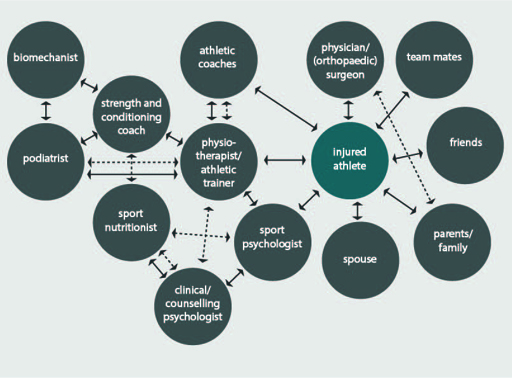2.1 The multidisciplinary support team
As you identified in Activity 2 there are potentially a wide range of people that can support the injured athlete/exercise participant. In an ideal world these people should work together to support the injured person in what is known as a multidisciplinary support team. Such a team may be more accessible to some than others. For example, a competitive athlete is perhaps more likely to have access to various professionals such as psychologists, physiologists, nutritionists and biomechanists, than an exercise participant would – particularly if they are part of a professional sports club or an elite athlete in a National Lottery funded sport.
It has been suggested that these multidisciplinary teams help injured athletes/exercise participants to access services that will enhance their rehabilitation from injury and facilitate a holistic treatment plan that uses a biopsychosocial approach (Clement and Arvinen-Barrow, 2013).
Activity 3 How do multidisciplinary teams work successfully?
Read about the treatment that Lois is having for her injury and answer the questions that follow.
Lois is having her Achilles tendon injury treated at a sports medicine clinic that is using a multidisciplinary team to support her. At the clinic she is working with a physiotherapist, a sports massage therapist, a sport and exercise psychologist, and a nutritionist. She is also receiving informal support outside the clinic from both her boyfriend Dave and her coach. |
- What are the benefits of Lois having this multidisciplinary support team?
- What might be some of the challenges of having a support team of this size and how can these be overcome?
- Think about any current or future role you hold in sport and fitness (e.g. coach, instructor, athlete or sports therapist) and consider what your specific role would be as part of a multidisciplinary team supporting someone with an injury?
Discussion
- The main benefit of Lois having a multidisciplinary support team is that it allows for her injury to be treated in a holistic way considering various aspects that might be contributing to the development and recovery of the injury. This facilitates a biopsychosocial approach which considers more than just the physical aspects of injury.
- The biggest potential challenge is communication. It is important that a multidisciplinary team works effectively together and communicates well. Failure to do this could result in the injured person receiving conflicting messages and cause confusion. Competing demands from the different people involved also need to be managed. For Lois’s support team to work effectively they should have clearly defined roles and boundaries within the team and ensure that channels of communication are open (e.g. regular team meetings).
- Reflecting on your potential role in a multidisciplinary team is really useful in developing a holistic or biopsychosocial approach to sport injury. A key area to think about is your professional boundaries – i.e. what are you and what aren’t you qualified to do? In the next section we will explore this more in relation to sport psychology support.
Figure 4 below illustrates all of the different relationships and communications that might need to be managed within a multidisciplinary team.
With such a wide range of people potentially supporting the injured person it is important that everyone is aware of their professional boundaries, which is what you will explore next.

